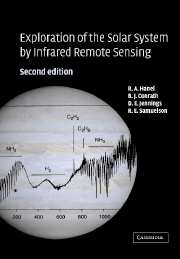Book contents
- Frontmatter
- Contents
- Introduction to first edition
- Introduction to second edition
- 1 Foundation of radiation theory
- 2 Radiative transfer
- 3 Interaction of radiation with matter
- 4 The emerging radiation field
- 5 Instruments to measure the radiation field
- 6 Measured radiation from planetary objects up to Neptune
- 7 Trans-Neptunian objects and asteroids
- 8 Retrieval of physical parameters from measurements
- 9 Interpretation of results
- Closing remarks
- Appendices
- References
- Abbreviations
- Index
5 - Instruments to measure the radiation field
Published online by Cambridge University Press: 07 September 2009
- Frontmatter
- Contents
- Introduction to first edition
- Introduction to second edition
- 1 Foundation of radiation theory
- 2 Radiative transfer
- 3 Interaction of radiation with matter
- 4 The emerging radiation field
- 5 Instruments to measure the radiation field
- 6 Measured radiation from planetary objects up to Neptune
- 7 Trans-Neptunian objects and asteroids
- 8 Retrieval of physical parameters from measurements
- 9 Interpretation of results
- Closing remarks
- Appendices
- References
- Abbreviations
- Index
Summary
In Chapter 4 we constructed examples of planetary spectra by applying solutions of the radiative transfer equation to model atmospheres of assumed composition and temperature structure. Before we can compare the results of such calculations with measured spectra we have to understand the modifications the emerging radiation field experiences in the recording process performed by radiometric instruments. A full comprehension of the detailed functioning of instruments is also necessary for the planning and the design of remote sensing investigations. Therefore, in Chapter 5 we discuss the principles of infrared instrumentation. We concentrate on instruments for space use, but the physical principles are equally applicable to ground-based astronomical sensors. On several occasions we refer to such Earth-based devices. It is neither possible nor useful to mention all infrared instruments ever flown in space or ever used for planetary work with ground-based telescopes. Instead, we analyze the physical concepts of different design approaches. To illustrate these concepts we occasionally show diagrams of specific instruments as well as samples of results obtained with them.
Radiometric devices have certain common characteristics. For example, most radiometric instruments contain optical elements to channel planetary radiation onto a detector. Telescopes are often essential parts of these designs. Following a brief introduction in Section 5.1, the subject of telescopes is discussed in Section 5.2. In the process of imaging a planetary surface element onto the detector, fundamental limits in spatial resolution are encountered. These limits, set by diffraction, are discussed in Section 5.3.
- Type
- Chapter
- Information
- Exploration of the Solar System by Infrared Remote Sensing , pp. 152 - 300Publisher: Cambridge University PressPrint publication year: 2003

